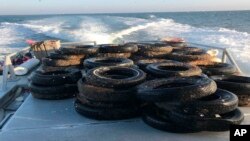Divers are removing hundreds of old tires, plastic jugs and other junk that was dumped off the Southern California coast nearly 30 years ago by a man who thought he was helping the ocean environment.
The cleanup began last week off of Newport Beach, the California Coastal Commission announced Wednesday.
“It's about time this was cleaned up. Dumping plastic and other trash into our oceans is not the way to restore the marine ecosystem,” commission Chair Dayna Bochco said in a statement. “There is an estimated 18 billion pounds of plastic that enters the world's oceans every year and we must do what we can to clean this up.”
In 1988, Rodolphe Streichenberger created what he described as an experimental, artificial reef.
The reef covered several acres of ocean floor and consisted of 1,500 used automobile tires, 2,000 one-gallon plastic jugs covered with plastic mesh, 100 sections of PVC pipe and other items, including fishing net, Styrofoam and iron roads, the commission said.
Streichenberger believed the reef would spur the growth of kelp forests, provide a place to grow mussels for commercial harvest and rebuild ocean habitat damaged by pollution and development.
The materials are “absolutely harmless,” Streichenberger told the Los Angeles Times in 1996. “You have seen no impact. Only fish. It's very good for the fish.”
But his research was “deeply flawed,” according to the Coastal Commission.
“State scientists said the tires contained harmful toxins, the material was not dense enough to anchor to the ocean floor and warned the discarded netting and ropes could trap fish and marine mammals,” the commission said in its statement.
“It's hard to believe there was a time when someone thought this was a good idea,” commission Executive Director Jack Ainsworth said. “We now know that plastic is poison in the ocean, polluting every level of the food chain.”
Streichenberger also had failed to obtain permission from the commission for the project. He was refused a retroactive permit in 1997 and the commission eventually issued a cease-and-desist order.
Streichenberger and his now-defunct Marine Forests Society sued, challenging the commission's authority. In 2005, the California Supreme Court reversed a lower court ruling and sided with the commission.
Streichenberger died the next year at 77.
Over the years, the Coastal Commission and the state Department of Fish and Wildlife kept tabs on the reef.
Instead of a thriving and diverse ecosystem, divers found that the junk had been spread around the sea floor by currents and held only “the type of marine life commonly found on pier pilings and boat bottoms,” the commission statement said.
“There's no native kelp, just a few fish swimming around,” said Kirsten Gilardi, assistant director at the Wildlife Health Center School at the University of California, Davis, which is involved in the cleanup. “It's nothing like the diversity and density you'd see on a natural rocky reef off the Southern California coast.”
Earlier this year, the Coastal Commission finally found a way to fund a cleanup through permit fees for a different underwater project at Hermosa Beach.
Since then, divers have been pulling tires from the water at the rate of about 100 a day, according to the commission.






